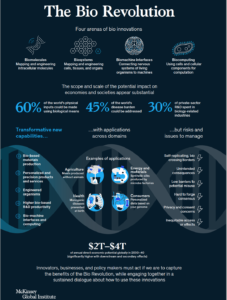Advances in biological sciences, accelerated by computing, automation, and artificial intelligence (AI), is fueling a new wave of innovation that will impact economies and societies that will surpass the industrial revolution.
In fact, these new capabilities and applications are already improving our response to global challenges from climate change to pandemics. But these innovations come with risks, arguing for a serious and sustained debate about the future of innovation in a world where the U.S. government was unable to mitigate the known threat of pandemics, despite decades of warning and months of prep time for an actual one.
The McKinsey Global Institute has published a tome, “The Bio Revolution” that attempts to quantify the risks and opportunities. The report’s key findings include the following:
- Increasing ability to understand and engineer biology. Recent advances include a sharp drop in the cost of sequencing DNA and the emergence of new techniques (including CRISPR) to edit genes and reprogram cells. So far, innovation in four arenas stands out: (1) biomolecules—the mapping, measuring, and engineering of molecules; (2) biosystems—the engineering of cells, tissues, and organs; (3) biomachines—the interface between biology and machines; and (4) biocomputing—the use of cells or molecules such as DNA for computation. All show various rates of progress from demonstration to commercial use;
- Transformative new capabilities. These innovations are creating five new potentially transformative capabilities: (1) biological means could be used to produce a large share of the global economy’s physical materials, potentially with improved performance and sustainability; (2) increased control and precision in methodology is occurring across the value chain from delivery to development and consumption with more personalization; (3) the capability to engineer and reprogram human and nonhuman organisms is increasing, potentially improving disease prevention and treatment as well as agricultural performance; (4) new methodologies using automation, machine learning, and proliferating biological data are enhancing discovery, throughput, and productivity in R&D; and (5) potential is growing for interfaces between biological systems and computers to, for instance, restore sensory function to the brain, and for biocomputers that could use DNA to store data;
- Substantial potential direct and indirect impact. As much as 60 percent of the physical inputs to the global economy could, in principle, be produced biologically—about one-third of these inputs are biological materials (wood or animals bred for food) and the remaining two-thirds are nonbiological (plastics or fuels) but could potentially be produced or substituted using biology. Therefore, it is possible that bio innovations could impact up to 60 percent of physical inputs, although attaining that full potential is a long way off. Even modest progress toward it could transform economies, societies, and our lives, including what we eat and wear, the medicines we take, the fuels we use, and how we construct our physical world. In human health, at least 45 percent of the current global disease burden could be addressed using science that is conceivable today;
- Visible pipeline of applications. Around 400 use cases, almost all scientifically feasible today, can be observed, mainly in human health and performance; agriculture, aquaculture, and food; consumer products and services; and materials, chemicals, and energy production. These use cases alone—more than half of which fall outside human health—could have direct economic impact of up to $4 trillion a year over the next ten to 20 years. The full potential could be far larger if we take into account potential knock-on effects, new applications yet to emerge, and additional scientific breakthroughs;
- Unique risks that require debate and mitigation. New biological capabilities come with profound and unique risks that need serious, ongoing debate, and proactive, rather than reactive, approaches toward mitigation. One such risk is that biological systems are self-sustaining, self-replicating, and interconnected, with potentially cascading and long-lasting effects on entire ecosystems or species; once Pandora’s box is opened, we could have little control over what happens next. Access to these tools may be relatively cheap and easy, making the potential for misuse considerable. Privacy and consent issues abound due to new forms of biological data. Responding to such challenges through cooperation and coordination may be complicated given competitive and commercial incentives and varying jurisdictional or cultural value systems;
- The timing of applications’ adoption and impact hinges on multiple factors. Adoption timelines, and therefore impact, will vary depending on several factors, including society’s approach to risks. There are three stages in the journey from lab to market: scientific research, commercial availability, and diffusion at scale. Science needs investment and to be proven. Resulting applications need to offer a value proposition against existing offerings, and able to be scaled. Diffusion and eventual impact will depend on public sentiment and mechanisms governing the use of different applications. About 70 percent of the total potential impact could hinge on societal attitudes and the respective mechanisms employed to govern use, such as regulations and societal norms;
- Stakeholders and contributors need to inform themselves about the Bio Revolution. Innovators, businesses, governments, and citizens need to become bio-literate in order to respond effectively to ongoing bio innovation, weighing risk against reward. The choices they make will influence the size and scope of the Bio Revolution’s benefits for economies, societies, and the planet.


